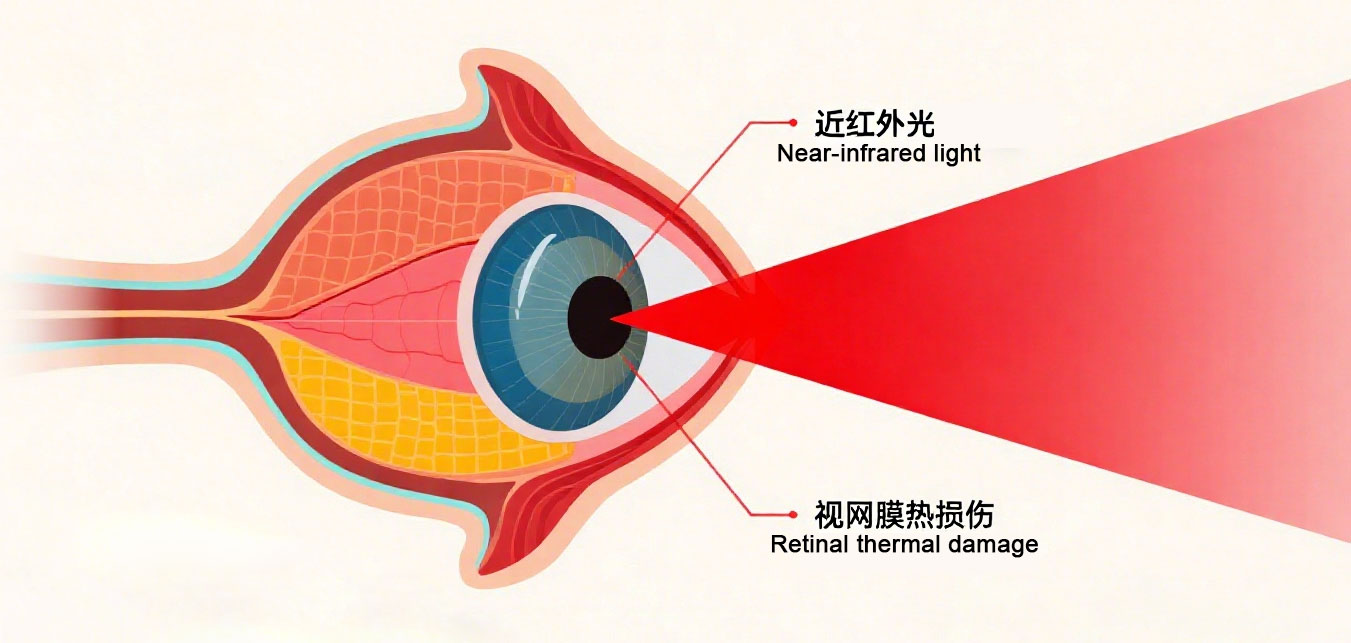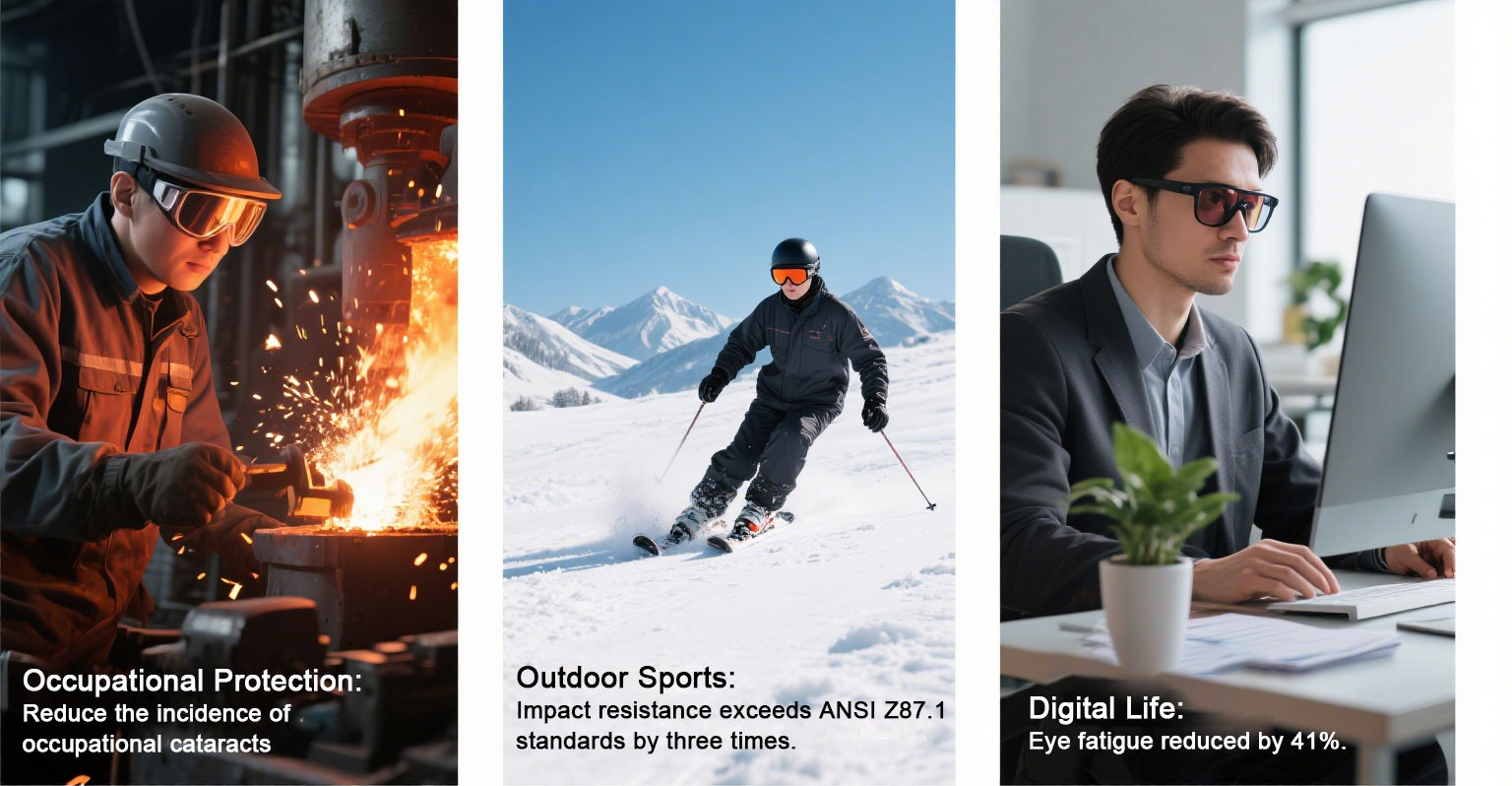In the digital age, the human eye faces unprecedented challenges. From infrared radiation from bright outdoor sunlight to high-energy blue light emitted by indoor electronic screens, light pollution has become a major threat to global vision health. According to international ophthalmology research institutes, approximately 12% of new cataract cases worldwide each year are directly related to long-term exposure to infrared light. Against this backdrop, red-light-blocking lenses, as a new generation of functional optical products, are redefining eye protection standards through technological innovation.
1.Near-infrared light: The overlooked "invisible killer of vision"
Infrared light accounts for 46% of total solar radiation energy, with near-infrared light (IRA) at a wavelength of 780-1400nm having the strongest penetrating power. Unlike the traditionally understood damage caused by ultraviolet light, near-infrared light can penetrate deep into the retina, where its thermal effects can denature lens proteins and cause irreversible cataracts. A clinical study at Tokyo Medical and Dental University in Japan showed that workers exposed to long-term infrared light were 3.2 times more likely to develop macular degeneration than the general population.
What's even more alarming is that the infrared radiation sources in modern life far exceed those in the natural environment. Industrial high-temperature equipment, infrared heating lamps, and even artificial light sources like car xenon headlights all generate high-intensity near-infrared radiation. Experiments at the Department of Ophthalmology at Seoul National University in South Korea have confirmed that exposure to an infrared heater for two hours at a distance of one meter can increase the temperature inside the eye by 2.3°C, enough to trigger apoptosis in lens cells.

2.Technical Breakthrough: Multi-layer Coating Creates a Protective Matrix
The core technology of anti-red light lenses lies in the nanoscale design of optical coatings. Take the GreenVision Red Shield series as an example. It utilizes a five-layer composite coating process:
Base layer: 1.60MR high-refractive-index resin is used to ensure optical distortion below 0.03%.
Infrared blocking layer: Indium tin oxide (ITO) and silicon dioxide are deposited alternately to achieve a 45% blocking rate in the 780-1400nm band.
Blue light filter: Utilizing patented BASF light-absorbing particles, it precisely intercepts harmful short-wavelength blue light in the 400-450nm range.
AR anti-reflective layer: Utilizing magnetron sputtering technology to create an 18-layer ultra-thin coating, it reduces mirror reflectivity to below 0.8%.
3.Market Applications: From Professional Protection to Universal Need
Red-light-blocking lenses have established three core application scenarios:
Occupational Protection: Essential equipment for high-temperature work environments such as metallurgy and glassmaking. Pilot data from a steel company showed that equipping employees with red-light-blocking goggles reduced the annual incidence of occupational cataracts from 0.7% to 0.12%.
Outdoor Sports: Eye protection in high-light environments such as skiing and mountaineering. PC-based red-light-blocking sports lenses offer impact resistance three times that of the ANSI Z87.1 standard.
Digital Life: Upgraded protection for screen users. A study by South Korea's INLOOK Laboratory confirmed that continuous use of red-light-blocking lenses for four hours reduced eye fatigue by 41% and the incidence of dry eye by 28%.

4. Industry Trends: Functional Integration and Intelligence
With advances in optical materials science, red light blocking technology is being deeply integrated with color-changing and polarizing features. Currently available optical color-changing red light blocking lenses can adjust their transmittance from 89% to 18% in just 30 seconds. More notably, intelligent photosensitive lenses, developed in collaboration with the Chinese Academy of Sciences, feature built-in microsensors that monitor the ambient light spectrum in real time and automatically adjust infrared blocking parameters, marking the transition from active eye protection to active defense.
Amidst the growing demand for vision health, red-light-blocking lenses have moved from the professional sector to the mass consumer market. According to Statista, the global functional lens market is projected to exceed US$28 billion by 2025, with the share of infrared-blocking products expected to increase from the current 7% to 15%. For lens manufacturers, mastering core coating technologies and building a comprehensive protection system will be crucial to future success.
Ideal Optical's red light-blocking lenses are now seamlessly integrated into our premium eyewear collection, enhancing your visual experience. By combining advanced photon filtering technology with our signature "comfort-first" design philosophy, we enable professionals and digital enthusiasts alike to enjoy clear vision while protecting against harmful red light exposure. Join thousands of satisfied customers worldwide who trust Ideal Optical for innovative eye care solutions that balance style and performance. Discover the future of digital eyewear today—the perfect blend of superior optical performance and 21st-century screen protection.
Post time: Aug-21-2025





